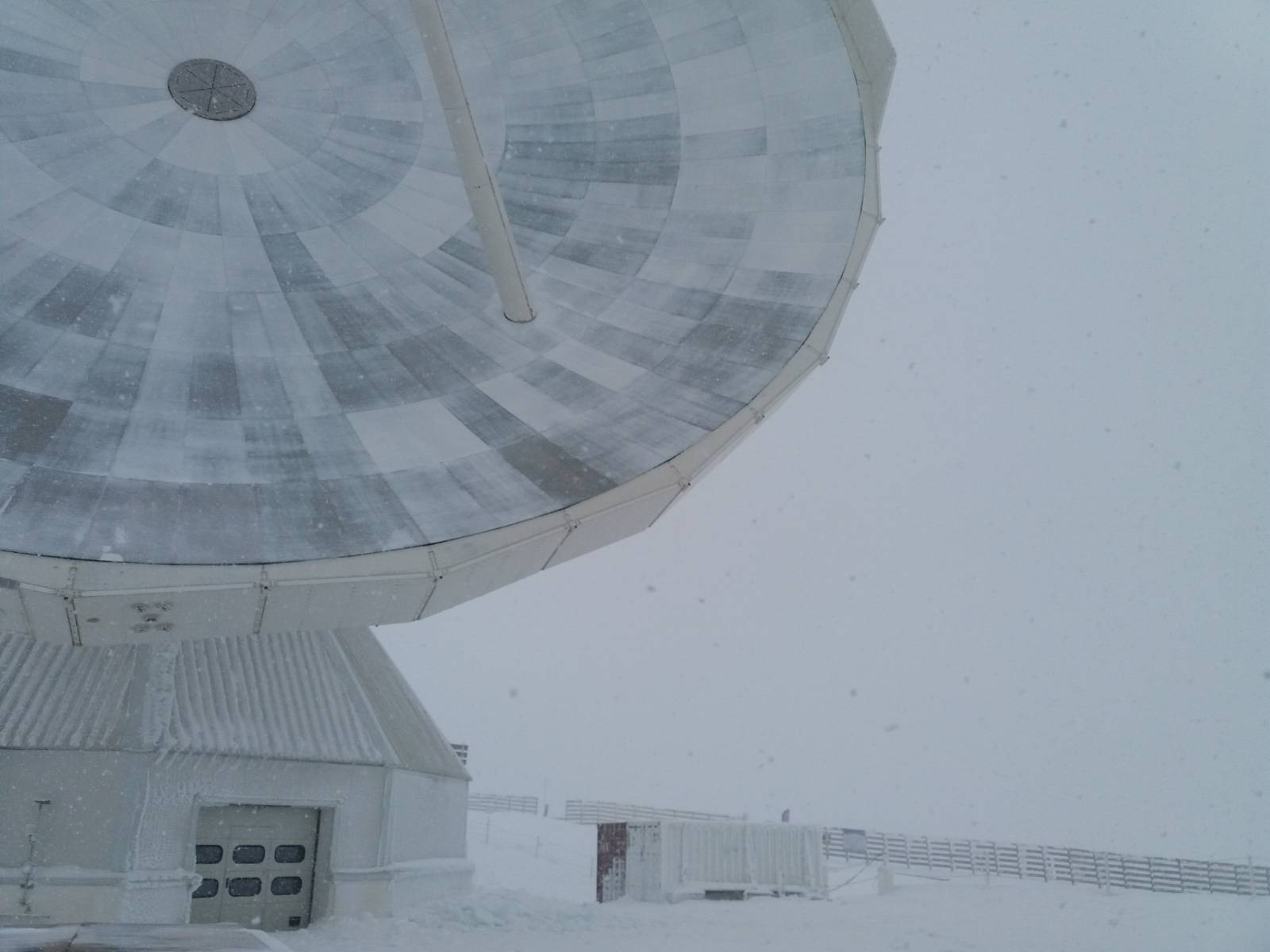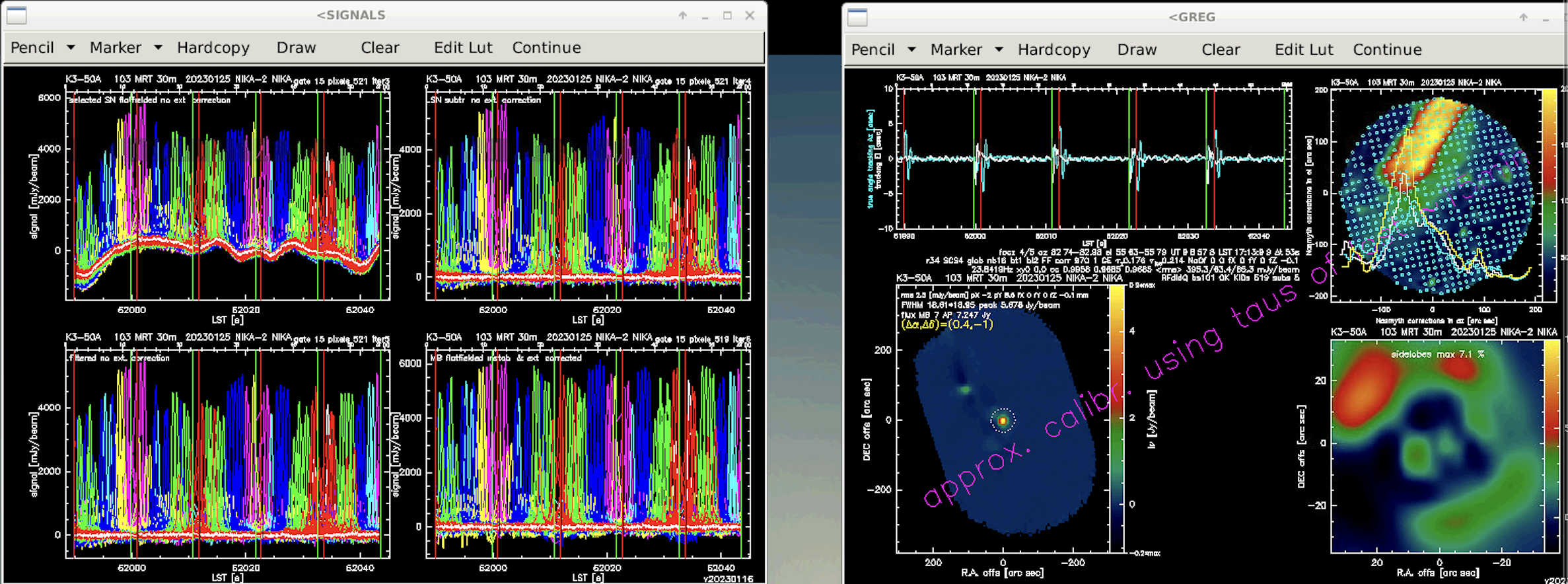Daily Reports
Contents
Jan. 24th, Tuesday
16:00-21:00; Stergios: Maintenance finished around 16:00 (local time). Snowing and dense clouds prevent us from observing even with EMIR.

Weather clearing up, however ice is present on the legs and sub-reflector (18:23 UTC). Operator removed successfully the ice/snow from the antenna. DAQ started around 19:00 UTC with final measurements of 49/6/62 bad pixels for arrays 1/2/3, respectively. We continued with calibration observations on the pointing source 2251+158. A series of pointing/focus revealed some kind of astigmatism with two 'lobes' present at the final image, which might be caused from the recent stop of the de-icing. After many focus repetitions on this source the feature persisted. Eventually we moved to Uranus aiming for better calibration results. Carsten takes over. Good stability (peak-to-peak always below 3 Jy/beam) and tau around 0.2 at most times.
21:00-03:00; Carsten: De-iciung had been on till 19:00UT. Beam and Focus looked poor till about 22:00UT. Pointing and focus on Uranus OK. Skydip. calib_1scan. COSMOS started at 22:30UT. tau225~0.28 slowly improving to 0.17. El>35deg. p2p<~4Jy/b@2mm on all the hourly pointings. The COSMOS timelines did however show larger variations +-5 up to 20Jy/b. 12 scans done.
Jan. 25th, Wednesday
03:00-09:00; FXD: 2 hours on COSMOS. I did focus in between. Best is 18x19 arcsec at 2mm. p2p variations are well below +-3 Jy/b on pointing scans. Tau=0.2 stable. -10 degC. Cloudy. No Wind. 2 repeats on 199-16 PSZ2G084 before it's too high. Focus (12 and 18) OK then go to PSZ2-G046.1. 4 repeats
09:00-15:00; Antoine: 1st hour spent trying to get a good focus as the rising sun was heating the antenna: weird feature/artifact when trying to focus on K3-50A (see screenshot), then switched to NGC7027 for better focus. After that good observations of program 199-16: finished observing PSZ2-G046.1. Then switched to project 171-22 to try to wrap up the last 3 repetitions of PSZG126. Two repetitions done, but at least 1 scan was lost because the auto-tuning of the KIDS got turned off (remote connexion at around 11h55 UTC ?). Then unfortunately there was a gap in visibility with no observable projects, so time was spent pointing, focusing and calibrating on different sources until 15h. Overall quite good weather conditions: no wind, very few clouds (if any), tau ~ 0.20. And many thanks to Stergios for helping me through my first shift of NIKA2 observations.

15:00-21:00; Gustavo: After pointing and calibration we moved to observe galaxy cluster PSZ2G115 of project 199-16. We did the requested 4 repetitions on this cluster with 4 scans each. We repeated the pointing after 3rd repetition. Then, we moved to project 122-16 to observe source B213E_N . After pointing, focus and calibration we started the scans until the object reached 67 deg altitude. We did two repetitions with two scans each. Finally, we moved to project 126-22. We did the last repetition on orion_b1. The KIDS autotune was a bit off, so we retuned the KIDS and proceeded to observe repetition 2 and 3 of orion_b2.
21:00-03:00; Carsten: Excellent conditions: tau225~0.1, p2p <1Jy/b @2mm, windy ~8-12m/s. As there is no large program on the sky, continuing with Orion B (126-22). 1h on Uranus for pointing, focus, calib_1scan, beam map. Conditions stay excellent. 22:30UT: Continuing with 192-16 COSMOS.
Jan. 26th, Thursday
03:00-09:00; FXD: Continuing excellent weather, telescope and instrument conditions. No wind, -10degC, tau=0.1. Continuing COSMOS till 5h30 UT. Then start the new source Oph_L1688 for project 122-16. Even at low elevation (20deg), the stability is good. Beam 17.9 and 12.2. p2p 2Jy/b at 2mm.
09:00-11:00; Antoine: Good weather conditions at 8 a.m: No wind, tau below 0.20, good atmospheric stability. Finished a scan of L1688. At 8h30 UTC pointing + focus on 1253-055 as the sun was up. Good focus and pointing. Went back to observe L1688 for one more repetition (~1h). Shift finished early at 9h55 a.m. UTC, time for EMIR observations until 16h UTC.
11:00-17:51; 087-21: POLAMI project observed from 11 UTC (one hour lost due to technical issues) until 16:15 UTC (15 min of additional time was offered due to delays with the earlier NIKA2 project). An EMIR test was required from the operator to check for possible spikes. Change back to NIKA2 was initiated at 16:51 UTC.
17:51-21:00; Gustavo: We initialized the NIKA2 camera at 18:00 CET after changing from EMIR observations. The data acquisition process had some problems at the beginning. PID 1 of the MACRT monitor was set of off, instead of on as it is suppose to be. After several tuning process, the number of bad pixels was 81, 6, 104. We then started the pointing and focus processes using Uranus. The pointing was failing dramatically. No sign from Uranus in the scans. After several trials on Uranus and other sources, we decided to reset NIKA2 and re-tune the KIDS again. The number of bad pixels after tuning was 43, 6, 58. We moved back to Uranus for pointing. This time it looked ok. The problems seemed to be solved after re-setting NIKA2. We did pointing, focus and Calibration on Uranus. We finished all these procedures at 19:40 CET. We then moved to project 126-022 to make the last repetition of orionb_4 target. During the scan, the weather conditions changed dramatically (20:00 CET). The maximum wind speed was above the limit and the operator cancelled the scan and put the antenna in safe position. The shift finished. No further observations made.
21:00-03:00; Carsten: UT20:00 Telescope in the clouds and still windy with gusts up to 12m/s. Stopped. UT20:23 De-icing switched on with reduced power. UT22:00 15-17m/s and cloudy. UT22:40 wind much lower. Clearing-up. tau225~0.17. Surface clean. De-icing switched off. Bad pixels: 49 / 7 / 61. Uranus. +-3Jy/b p2p 2mm. Beam 17.9x21.3. calib_1scan 183. Pointing near COSMOS-Field. 17.6"x18.5" beam improved. UT23:30 COSMOS started. Doing a pointing after a scan on COSMOS, it takes 3min to have pointing results with IDL, and 6min to have them with QL (at 2mm).
Jan. 27th, Friday
03:00-09:00; FXD: Continue hammering the COSMOS till UT5h30. Tau225=0.12. Beam is excellent 17.7 11.4", p2p 0.5Jy/b @2mm, no wind -11degC. Switch to 122-16. Focus, Pointing, then L1688 with scans with step of 30" (24min). Tau is down at 0.1. Very stable.
09:00-15:00; Antoine: Finished a repetition of L1688 then did another one. After that switched to project 199-16 and observed PSZ2-G084 for 2.2 hours straight, only 1 pointing was necessary. Conditions were very good, tau~0.12 and pea2 to peak variation on the maps below 4 Jy/beam, no focused needed. Observations of PSZ2-G084 are finished. After that gap in the observable sources, so pointing + focus + calib1_scan and then observation of project 089-22 from the summer pool to fill the gap.
15:00-21:00; Gustavo:
21:00-03:00; Carsten: UT20:19 Wind just below the limit. Bad pixels: 47/6/70. Uranus. tau225=0.17. calib_1scan. Wind peaks <10m/s. UT21:00 126-22 Orion B. Beam 17.3x18.0. tau225~0.13. +-2Jy/b p2p 2mm. All perfect.
Jan. 28th, Saturday
03:00-09:00; FXD:
09:00-15:00; Antoine:
15:00-21:00; Gustavo:
21:00-03:00; Carsten:
Jan. 29th, Sunday
03:00-09:00; FXD:
09:00-15:00; Antoine:
15:00-21:00; Gustavo:
21:00-03:00; Carsten:
Jan. 30th, Monday
03:00-09:00; FXD:
09:00-15:00; Antoine:
15:00-21:00; Gustavo:
21:00-03:00; Carsten:
Jan. 31st, Tuesday
03:00-09:00; FXD:
